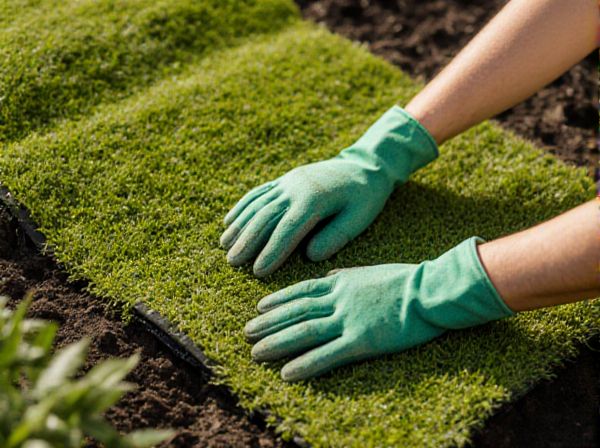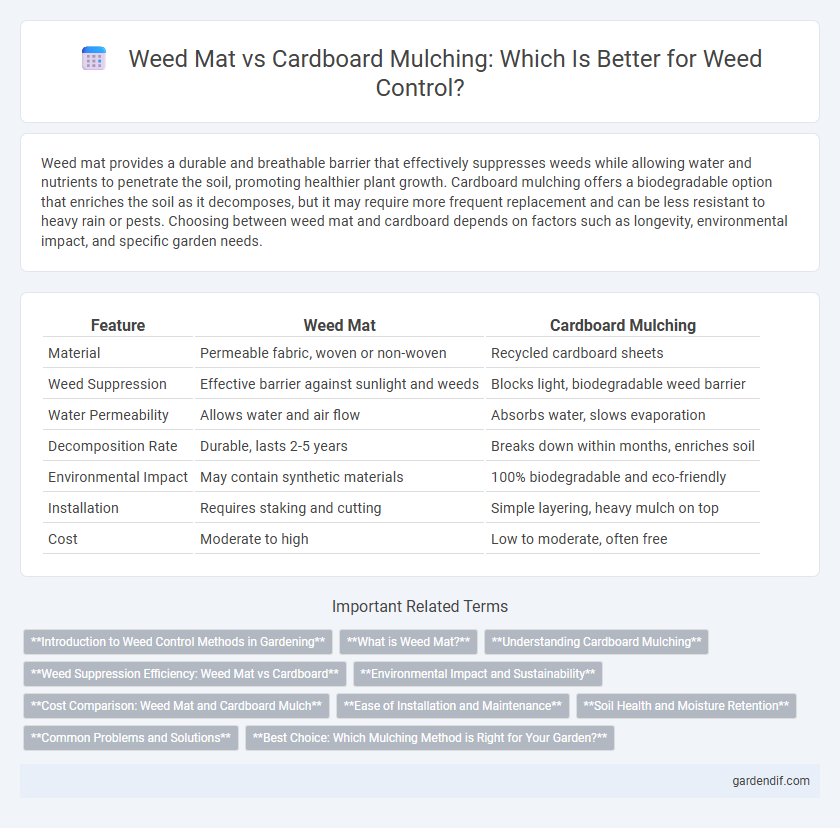
Weed mat vs cardboard mulching Illustration
Weed mat provides a durable and breathable barrier that effectively suppresses weeds while allowing water and nutrients to penetrate the soil, promoting healthier plant growth. Cardboard mulching offers a biodegradable option that enriches the soil as it decomposes, but it may require more frequent replacement and can be less resistant to heavy rain or pests. Choosing between weed mat and cardboard depends on factors such as longevity, environmental impact, and specific garden needs.
Table of Comparison
| Feature | Weed Mat | Cardboard Mulching |
|---|---|---|
| Material | Permeable fabric, woven or non-woven | Recycled cardboard sheets |
| Weed Suppression | Effective barrier against sunlight and weeds | Blocks light, biodegradable weed barrier |
| Water Permeability | Allows water and air flow | Absorbs water, slows evaporation |
| Decomposition Rate | Durable, lasts 2-5 years | Breaks down within months, enriches soil |
| Environmental Impact | May contain synthetic materials | 100% biodegradable and eco-friendly |
| Installation | Requires staking and cutting | Simple layering, heavy mulch on top |
| Cost | Moderate to high | Low to moderate, often free |
Introduction to Weed Control Methods in Gardening
Weed mats and cardboard mulching are effective organic weed control methods that suppress weed growth by blocking sunlight and reducing soil disturbance. Weed mats, typically made from woven polypropylene, provide long-lasting durability and allow water and nutrients to penetrate while preventing weed emergence. Cardboard mulching uses biodegradable layers to smother weeds, improve soil moisture retention, and enrich organic matter as it decomposes, offering an eco-friendly alternative for sustainable gardening.
What is Weed Mat?
Weed mat is a durable, permeable fabric designed to suppress weed growth by blocking sunlight while allowing water and nutrients to reach the soil. Commonly made from woven polypropylene or polyester, it provides effective long-term weed control without the need for chemical herbicides. Unlike cardboard mulching, weed mats are reusable, require less maintenance, and offer superior durability in various gardening and landscaping applications.
Understanding Cardboard Mulching
Cardboard mulching suppresses weed growth by blocking sunlight, which prevents weed seeds from germinating while enriching soil as it decomposes. This method improves soil structure and retains moisture more effectively than traditional weed mats, which can sometimes hinder water penetration and microbial activity. Cardboard, being biodegradable, offers an eco-friendly solution that promotes healthier plant growth and reduces plastic waste.
Weed Suppression Efficiency: Weed Mat vs Cardboard
Weed mats provide superior weed suppression efficiency by creating a durable, breathable barrier that blocks sunlight and prevents weed germination more effectively than cardboard. Cardboard mulching decomposes faster, requiring more frequent replacement, and may allow weeds to penetrate as it breaks down. The longevity and permeability of weed mats ensure consistent weed control and soil moisture retention, making them a more efficient choice for long-term weed management.
Environmental Impact and Sustainability
Weed mats, typically made from polypropylene, offer long-lasting weed suppression but can contribute to microplastic pollution and are not biodegradable, raising concerns about soil health and long-term environmental impact. In contrast, cardboard mulching utilizes recycled, biodegradable material that enriches the soil as it decomposes, promoting sustainable gardening practices by reducing waste and supporting microbial activity. Choosing cardboard mulching aligns with eco-friendly landscaping goals and reduces reliance on synthetic materials, fostering improved soil quality and biodiversity.
Cost Comparison: Weed Mat and Cardboard Mulch
Weed mat typically costs between $0.10 to $0.50 per square foot, making it a higher initial investment compared to cardboard mulch, which averages around $0.05 to $0.15 per square foot, often sourced from recycled materials. While weed mats offer durability and longer-lasting weed suppression, cardboard mulch provides an affordable, biodegradable option that improves soil organic matter over time. Factoring in labor and replacement frequency, cardboard mulch can be more cost-effective for large garden areas or temporary weed control.
Ease of Installation and Maintenance
Weed mats offer superior ease of installation by lying flat and requiring minimal cutting to fit garden shapes, while cardboard mulching demands more preparation to avoid gaps. Maintenance is simpler with weed mats as they provide a durable, reusable barrier against weeds, unlike cardboard which breaks down and needs frequent replacement. The long-lasting nature of weed mats reduces labor over time, making them more convenient for sustained weed control.
Soil Health and Moisture Retention
Weed mats improve soil health by allowing better aeration and water infiltration compared to cardboard mulching, which can create a barrier that limits gas exchange. Weed mats promote consistent moisture retention without becoming waterlogged, supporting beneficial microbial activity and root growth. Cardboard mulching, while biodegradable, can sometimes retain too much moisture or dry out too quickly, impacting soil structure and microbial diversity.
Common Problems and Solutions
Weed mats often face issues like tearing and limited biodegradability, while cardboard mulching can struggle with slower decomposition and inconsistent weed suppression. Solutions include using reinforced or UV-stabilized weed mats to enhance durability and choosing thick, untreated cardboard for more effective mulch layers. Proper installation and periodic monitoring help both methods maintain optimal weed control and soil health.
Best Choice: Which Mulching Method is Right for Your Garden?
Weed mats offer superior weed control and durability compared to cardboard mulching, effectively blocking sunlight and preventing weed growth for multiple seasons. Cardboard mulch excels in eco-friendliness and soil improvement as it decomposes, enriching the garden bed with organic matter. Choosing the best mulching method depends on your garden's long-term maintenance goals and environmental preferences, with weed mats favored for convenience and longevity, while cardboard suits growers prioritizing soil health and sustainability.
Weed mat vs cardboard mulching Infographic

 gardendif.com
gardendif.com